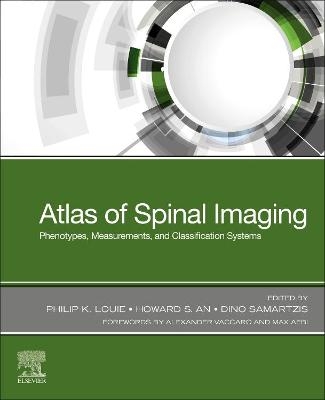
Atlas of Spinal Imaging
Elsevier - Health Sciences Division (Verlag)
978-0-323-76111-6 (ISBN)
*Includes a Foreword by renowed spine surgeons Alexander Vaccaro and Max Aebi*
Helps readers better understanding spinal phenotypes and their imaging, and how today's knowledge will facilitate new targeted drug discovery, novel diagnostics and biomarker discovery, and outcome predictions.
Features step-by-step instructions on performing the radiographic measurements with examples of normal and pathologic images to demonstrate the various presentations.
Presents clinical correlation of the phenotypes as well as the radiographic measurements with landmark references.
Includes validated classification systems that complement the phenotypes and radiographic measurements.
Complies the knowledge and expertise of Dr. Dino Samartzis, the preeminent global authority on spinal phenotypes who has discovered and proposed new phenotypes and classification schemes; Dr. Howard S. An, a leading expert in patient management and at the forefront of 3D imaging of various spinal phenotypes; and Dr. Philip Louie, a prolific surgeon who is involved in one of the largest machine learning initiatives of spinal phenotyping.
Dr. Philip Louie recently joined the Spine Team at the Virginia Mason Neuroscience Institute. He received his Bachelors Degree in Business Administration as well as Molecular, Cellular, and Developmental Biology at the University of Washington. He subsequently completed his Medical Degree (MD) at the University of Washington School of Medicine. Dr. Louie completed his Orthopaedic Surgery Residency at Rush University Medical Center with Midwest Orthopaedics. At which point, he was a founding member of the International Spine Research & Innovation Initiative (ISRII). During his residency, he developed a training simulator focusing on the fundamental skills in spine surgery, and subsequently won the Golden Apple Chief Resident Teaching Award. Dr. Louie completed an Orthopaedic Spine Surgery Fellow at the Hospital for Special Surgery in New York City. He has authored over 100 peer-reviewed publications as well as numerous abstracts, book chapters, and regularly presents research at both national and international conferences. As one of the leading authorities on spinal surgery, Dr. Howard An has published more than 300 peer-reviewed original articles, 110 chapters and 20 books on spinal surgery and instrumentation. Dr. An has held the inaugural Morton International Endowed Chair position at Rush University Medical Center since 1997, and is the Director of the Spine Surgery Fellowship Program at Rush. He held the position of Director of the Division of Spine Surgery for 14 years. A medical graduate from the Medical College of Ohio in 1982, Dr. An stayed at the school to complete his internship and residency in orthopedic surgery. He followed his internship and residency with a spine surgery fellowship at Rothman Institute-Pennsylvania Hospital and Jefferson Medical College in Philadelphia. Dr. An is a recipient of the 1990 North American Traveling Fellowship from the American Orthopaedic Association, the 1995 Scoliosis Research Society Traveling Fellowship, and the 2011 Kappa Delta Award from Orthopaedic Research Society and American Academy of Orthopaedic Surgeons. Dr. An has served as a board and committee member of several medical societies and associations, including the North American Spine Society, International Society for the Study of the Lumbar Spine (president in 2010), Cervical Spine Research Society, Scoliosis Research Society, Orthopaedic Research Society, and American Orthopaedic Association. Dr. Samartzis obtained his undergraduate degree from Northwestern University, and further pursued graduate studies in biological sciences, evidence-based health care, clinical epidemiology, medical sciences, and international studies at Harvard University, University of Oxford (UK), University of Cambridge (UK), Erasmus University (The Netherlands), Charles University (Czech Republic), and London School of Economics and Political Science (UK). He completed a postdoctoral fellowship at the The University of Hong Kong. He went on to become the Gilbert Beebe Fellow of the Radiation and Nuclear Board of the National Academies of Science in Washington D.C. and the United States Department of Energy, the Radiation Epidemiology Branch of the National Institutes of Health in Bethesda, Maryland, and at the Radiation Effects Research Foundation (a.k.a. Atomic Bomb Casualty Commission) in Hiroshima, Japan. He has published over 350 peer-reviewed studies in high-impact journals (e.g., Lancet, Arthritis & Rheumatism, JBJS, etc.), book chapters and web-based articles.
1. Introduction
Section I
2. Radiographic Evaluation of the Upper Cervical Spine
3. Upper Cervical Spine MRI
4. Upper Cervical Spine: Computed Tomography
5. Clinical Correlations to Specific Phenotypes and Measurements With Classification Systems,
Section II
6. Subaxial Cervical Spine Plain Radiographs
7. Magnetic Resonance Imaging Techniques for the Evaluation of the Subaxial Cervical Spine
8. Subaxial Cervical spine CT
9. Clinical Correlations to Specific Phenotypes and Measurements with Classification Systems
Section III
10. Full-Length Spine - Plain Radiographs
11. Interest of Full-Length Spine CT and MRI in Daily Practice
12. Full-Length Spine - Clinical Correlations with Specific Phenotypes and Measurements With Classification Systems
Section IV
13. Lumbar Spine Plain Radiographs
14. Lumbosacral Spine MRI
15. Lumbosacral CT
16. Clinical Correlations to Specific Phenotypes and Measurements With Classification Systems: Lumbosacral Spine
Section V
17. Future Trends in Spinal Imaging
| Erscheinungsdatum | 29.03.2021 |
|---|---|
| Verlagsort | Philadelphia |
| Sprache | englisch |
| Maße | 191 x 235 mm |
| Gewicht | 610 g |
| Themenwelt | Medizin / Pharmazie ► Medizinische Fachgebiete ► Onkologie |
| ISBN-10 | 0-323-76111-9 / 0323761119 |
| ISBN-13 | 978-0-323-76111-6 / 9780323761116 |
| Zustand | Neuware |
| Haben Sie eine Frage zum Produkt? |
aus dem Bereich


